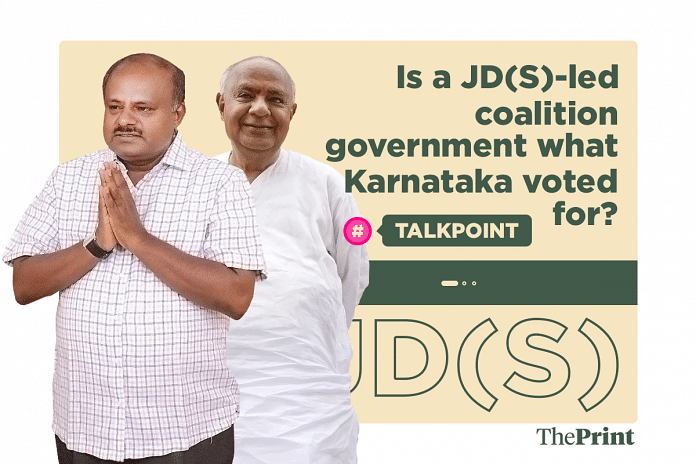As the BJP tally in Karnataka appears to be stopping short of a majority, the Congress has made an unconditional offer to JD (S) leader H.D. Kumaraswamy to lead a new coalition government as the chief minister.
ThePrint asks: Is a JD (S)-led coalition government what Karnataka voted for?
People of Karnataka deserve a better government than a proxy chief minister of the Congress.
 Seshadri Chari
Seshadri Chari
Former editor, Organiser
The sudden political changes in Karnataka have come as a rude shock not only for the BJP, but also the 80 per cent of the voters who voted either for the BJP or the Congress.
In spite of winning almost the same percentage of votes as the Congress, the BJP has more seats as a result of the first-past-the-post system.
The tragic part of democracy is that a party with just 17 per cent of the votes and less than half the Congress’ seat share — a party that declared it would neither support the BJP nor the Congress; a party deserted by Siddaramaiah, who subsequently headed a Congress government as chief minister; a party whose president had to resign as Prime Minister because of the Congress — is now all set to come to power with the help of the Congress in Karnataka.
People of the state certainly deserve a better government than one headed by a proxy chief minister of the Congress. If the present arrangement of H.D. Kumaraswamy as chief minister and Congress members as deputy chief minister and assembly speaker succeeds, it will be a sad day for democracy.
Kumaraswamy did not keep up the promise he made the last time as part of a similar coalition arrangement with the BJP years ago. He was supposed to vacate the CM’s chair after a while, but instead scrapped the deal when his term ended, and brought about instability. There is no reason to believe Kumaraswamy will give a stable government this time.
The BJP can’t be said to have the mandate of the people in Karnataka either.
 Shivam Vij
Shivam Vij
Contributing editor, ThePrint
Did Karnataka vote for H.D. Kumaraswamy as chief minister? Well, it hasn’t given any party a clear majority. The BJP may be the single largest party just a few seats short of the halfway mark, but it can’t be said to have the mandate of the people either.
What did Karnataka vote for then? A hung assembly. As this writer noted from Bengaluru a week ago, the election hawa in Karnataka favoured a hung assembly. It was as if the people wanted a hung assembly, since they weren’t too sure about either the Congress or the BJP.
This is no surprise for Karnataka, which has had unstable governments and coalitions forever. The five years under Siddaramaiah were an exception. Ahead of the 2013 assembly elections, BJP leaders B.S. Yeddyurappa and B. Sriramulu had split from the party. This had enabled the Congress to win a rare majority.
But 2018 looks more like 2008. Ten years ago, the BJP had won 110 seats, just three short of the majority mark, and the JD(S) bargained and blackmailed so hard that the two parties came up with a 20-20 formula: Kumaraswamy and Yeddyurappa would be CM for 20 months each.
There is no reason why Kumaraswamy becoming CM with the Congress’ support would be undemocratic or against the will of the people. Such an arrangement would have the support of over half the state’s MLAs, who would be expressing the will of the people, or political self-interest, which may sometimes be the same thing.
Congress staking claim to be in government perverse, against mandate

Rajeev Chandrasekhar
MP, BJP
This election was clearly a rejection of the performance of Congress and Rahul Gandhi and the Siddaramaiah government. The majority of the MLAs that have been elected are those who opposed the Congress government. They were the anti-incumbency warriors, if I may call them that. Therefore, for the Congress today to stake a claim directly or indirectly for continuing to be in the government in Karnataka is perverse and going against mandate.
Clearly, in a nutshell, I do not believe the state of Karnataka and the city of Bengaluru voted for having a JD(S) coalition, that too with Congress, as a successor of the Congress government. That is an absolute and emphatic no.
BJP has substantially expanded its number of MLAs. There were 40 in the outgoing assembly and more than 100 in the incoming one. BJP suffered a series of narrow losses in constituencies like Tumkur and Sringeri, which shows a clear vote-for-change campaign and there definitely was a momentum for that among the public too.
The campaign to oust Congress and throw the incumbent out has benefited JD(S) too. The future of Congress nationwide is a question; they don’t stand for any ideology for the future. Their campaign, like in Gujarat, has just been a hit job, creating paranoia and divisions, rather than a coherent picture of the future.
In Karnataka, I think BJP will definitely form the government. This will also open up south India for BJP’s expansion and providing alternatives to states that have long suffered the current kinds of governments. It might not be immediate though. There will be a few roadblocks by the Congress, but eventually, the popular mandate is what will be reflected in the government.
As long as there is consensus among two parties, a JD(S)-led govt should not seem abnormal
 Chandan Gowda
Chandan Gowda
Professor of Sociology, Azim Premji University
There is no one people of Karnataka. We live in a multi-party system that reminds us everyday that there are constituencies of people with different interests and different aspirations for what they would want a government to be like and do when in power. We have gotten used to this idea at the level of the centre where we have coalition governments now for over two decades. We really don’t expect a single party to govern there anymore.
Similarly in the state, if we look at JD(S)’s main support base in the old Mysuru region, which was formerly a separate kingdom that could have asked to remain a separate state. But it chose to join the larger state. So, it’s safe to presume that this part of the state is comfortable with this party representing them. The JD(S) has consistently got half a dozen seats in the Hyderabad Karnataka region too. The Congress has been able to get seats across the state and they represent certain constituencies and people. Put together, they form more than half the numbers required to legitimately form the government.
A full majority does not always mean that a whole people are with you. The idea that only one party runs the government need not be the only model of legitimate government and a coalition government could be a better norm. Karnataka is a constellation of diverse regions and constituencies. So, it should not surprise anyone that diverse aspirations end up needing coalition arrangements. What we need are evolved styles of sharing power within them.
Who becomes the CM is an internal decision and Congress has offered the post to H.D. Kumaraswamy. As long as there is consensus across the two parties, a JD(S)-led government should not seem abnormal. It is simply a coming together of two parties who are authorised to take this decision on behalf of the people they represent.
Compiled by Sandhya Ramesh, Sr. Asst. Editor, Science



